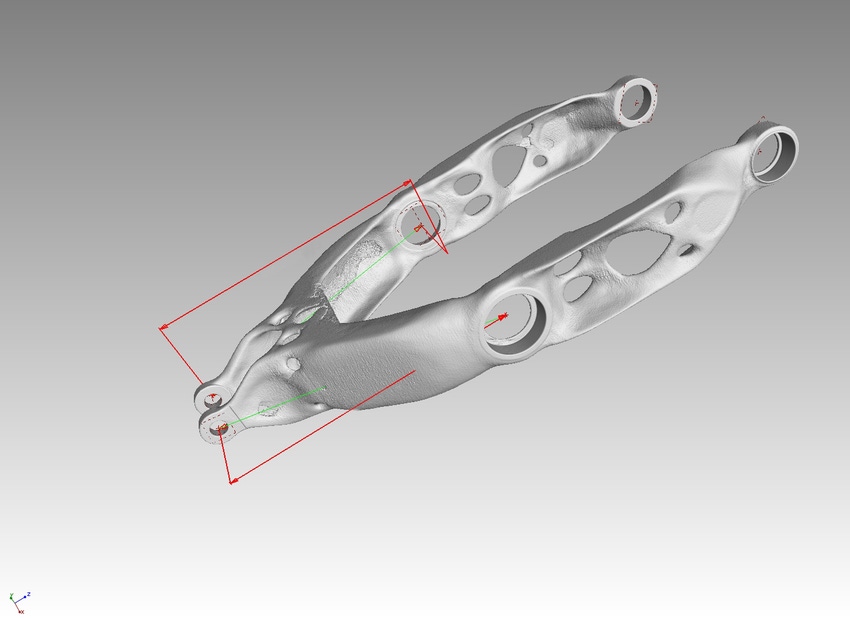CT Scanning Helps Lighten Load in Additive Manufacturing for Aerospace
In some cases, CT scanning isn’t just the best technique, but the only way to detect, measure, and see hidden features.
November 6, 2018

Additive manufacturing is a fast-evolving technology, especially for the aerospace industry. One of its most important benefits in aerospace applications is decreasing weight. Just a small savings in weight on an aircraft can mean big savings in fuel consumption, which is good for the industry as well as the environment.
|
Shown is a helicopter bell crank with different types of measurements collected for analysis. (Image source: YXLON International) |
However, reducing weight means designing very intricate and geometrically complex parts that can be very difficult to inspect. Additive manufacturing has moved beyond just making a “copy” of the part, as it was conventionally produced, to making designs of which engineers could previously only dream.
These new designs often include features that you can’t see, touch, or detect in any other way than X-Ray computed tomography (CT). In some cases, it isn't just the best technique, but the only technique to detect, measure, and see these hidden features.
Seeing More
CT is the latest, and perhaps the most powerful, development in the modern era of non-destructive testing. A CT scan produces a two-dimensional density map of a cross-sectional slice of an object’s interior. A 3D volumetric model can be produced from many of these views taken at many different viewing angles, which are then reconstructed using a computer. Many 2D slices can be combined with powerful software to produce a 3D image of practically any part, object, or product. This is critical for any application for which a manufacturer wishes to see inside an object without destroying it.
|
High-resolution industrial computed tomography (CT) systems are available for small, medium, and large parts X-Ray inspection. (Image source: YXLON International) |
Today’s industrial CT systems have advanced functional capabilities that provide extremely valuable data for initial prototyping and optimizing production processes. For example, a ten-minute scan with CT is much more productive than spending several days to look at porosity using traditional NDT inspection methods. CT scans can detect potential part failures, even on larger parts. That’s because CT scanning techniques are known for producing crystal clear images that are superior to other modality choices. These images can assist manufacturers in a comprehensive fatigue analysis of parts as well as identify finite cracks and inconsistencies from part to part.
Substrate bonding issues, uneven material flow, and density and porosity problems can also be detected through the accuracy of CT images. CT screening can help to improve productivity as well by eliminating issues that could potentially cause problems in post-production.
Take Off Weight
CT scanning can help take the weight off your shoulders when it comes to solving the most challenging problems in NDT techniques. Let’s look at one application example, where CT played a crucial role in the inspection of a very intricate part design for a helicopter.
A bell crank, to incorporate the rotor blade, was produced via additive manufacturing from a titanium-aluminum alloy. In the case of this method, the driving factors were a reduction of the part’s weight while retaining identical mechanical attributes. Optimizing the part design made it possible for the additive manufacturer to achieve a weight reduction of approximately 30 percent.
Quality control played a mandatory role, due to the part’s relevance to safety. Factors to be considered as particularly crucial to quality were deformations of the bell crank—for example, the parallelism exhibited by the crank arms. This also applied to precision bores and their diameters. The size, location, and geometry of remaining gas inclusions made statements possible pertaining to the part’s fatigue strength, as well as regarding its machining process reproducibility.
RELATED ARTICLES
The high-resolution that CT images provide is ideal for tasks like this because it enables the precise surface identification necessary for metrology—down to the smallest sub-regions of the three-dimensional grid. With CT, you can scan it and resolve all these issues in a very finite amount of time. There’s not another technique that allows you to do all this.
Jason Robbins is global segment manager, aerospace, with YXLON International, which designs and produces radioscopic and CT inspection systems for a broad variety of industrial applications.
|
About the Author(s)
You May Also Like






